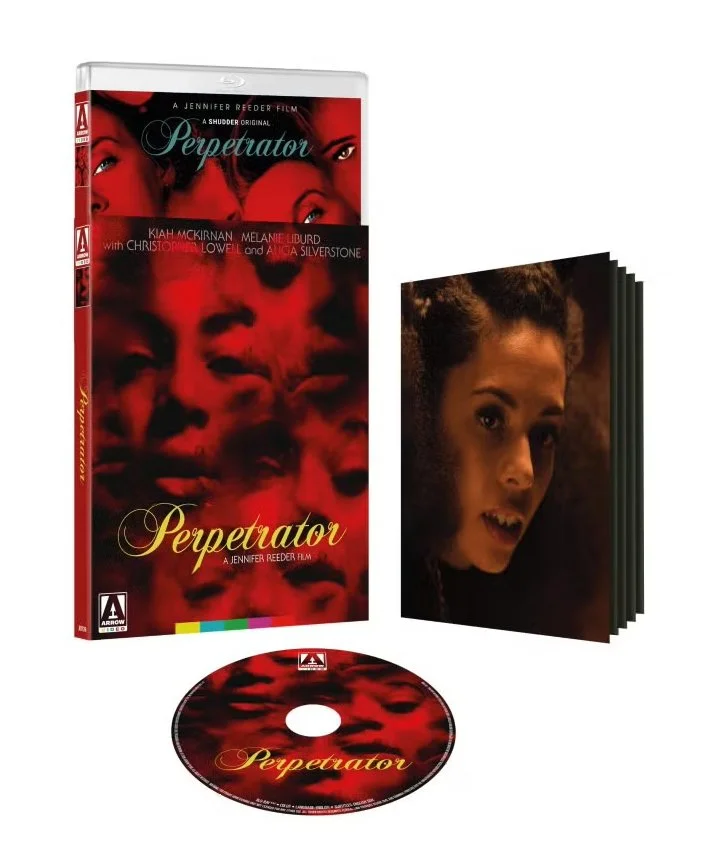COMMENTARY On Jennifer Reeder’s “Perpetrator” (on the Occasion of its Arrow Video Release), Ducournau & Resonances of the New French Extremity
Poster, Perpetrator by Jennifer Reeder. Image Courtesy Arrow Video.
COMMENTARY
Perpetrator
By Jennifer Reeder
High Definition (1080p) Blu-ray ($28)
Arrow Video
By Michael Workman
I’ve followed Jennifer Reeder’s work since her early days as a video artist, in her “Clit-O-Matic” era and before, and had the joy of jurying an early edition of the Chicago Underground Film Festival, where she received a unanimous jury vote for Best of the Fest. Her bold, genre-planking work has continued to break new ground ever since. Originally released in 2023, the film now returns in a new edition from the renowned second-look label and independent distributor Arrow Video—a milestone too for the broader ecology of contemporary art cinema. Arrow’s involvement marks Perpetrator’s transition from festival-circuit acclaim and niche streaming audiences into the enduring cultural space of physical media and curated distribution, and a hopeful moment for the future of art house and genrefuck cinema: a reminder that there remains a robust audience for formally ambitious, politically engaged filmmaking outside the studio system, and that such work can thrive on its own terms when given the support of platforms that understand its value.
That conviction—of the enduring necessity of independent vision—is at the heart of what we’re doing with Bridge Video, and why we chose Perpetrator as the film to launch our new alternating audio/visual weekly Wednesday feature (with breaks). Each installment of this series will spotlight films, performances, and moving-image works that refuse easy categorization, and Reeder’s latest is a perfect place to begin. Set against the familiar gothic grammar of the coming-of-age horror film it pushes the genre into the thresholds that connect violence, and the experience of identity transformation in the transition to adulthood, but here she distills those preoccupations into something both dissonately mythic and urgently contemporary. The film follows Jonny Baptiste (Kiah McKirnan), a teenage girl sent to live with her enigmatic Aunt Hildie (Alicia Silverstone) after a string of girls go missing in her town. What begins as a familiar missing-persons mystery quickly mutates into a metaphysical exploration of female embodiment, rage, and resilience, anchored by performances that are as eerie as they are emotionally acute.
Like Julia Ducournau—whose Raw (2016) and Titane (2021) have come to define a new era of feminist body horror deliciously referred to as New French Extremity—Reeder approaches the work not merely as a vehicle for spectacle or shock but as a way of thinking through the body’s political and affective dimensions. Both filmmakers use corporeality as metaphor: for Ducournau, flesh becomes a site of transformation, a battleground on which questions of desire and societal expectation are (at times) literally written in the flesh. Likewise, Reeder’s treatment of blood as a sentient force in Perpetrator operates within the same lineage, but with a distinctly American, Gothic inflection — blood here is not only a marker of violence but also a conduit of inheritance, a connective tissue binding women across generations of trauma and resistance.
The kinship extends beyond metaphor. Both directors destabilize the horror genre’s traditional architectures — the “final girl” trope, the predator-prey binary — and replace them with narratives where female agency is diffuse, volatile, and often monstrous in its refusal to be contained. In Raw, cannibalistic hunger becomes a metaphor for emergent sexuality and social rupture—I will never forget the fridge-lit scene of a succulently devoured raw chicken breast; in Perpetrator, Jonny’s awakening power — literally coursing through her veins — is framed as a radical form of self-determination in a world that seeks to disappear her and other young women like her.
Left: The new Arrow Video Limited Edition Blu-ray edition of Perpetrator.
Even formally, Reeder shares with Ducournau a sensibility attuned to bodily excess and affective dissonance, with a palette that evokes rage and an atmosphere of tenderness infused with an other, attendant atmosphere of ambient potential violence, seemingly at every possible turn. Both embrace a visual language of saturation and surrealism, deploying color, viscera, and gesture not just for atmosphere but as carriers of meaning. Where Ducournau’s camera lingers on skin and muscle, Reeder’s follows blood as it seems to become sentient and traverses space — a creeping, unstoppable presence that refuses erasure.
Silverstone, in particular, commands the screen with a knowing matriarchal ferocity—her Hildie is part mentor, part sorceress, and part embodiment of the film’s deeper themes: that power, like blood, is both inherited and made. For me, this idea is framed with memories of watching Reeder post about concocting the film’s stage blood herself, sharing images on her social media feed, a choice that literalizes the film’s core proposition: that women’s suffering, their bodily knowledge, and their shared lineage of endurance are not passive residues of history but materials of active agency that continue to determine the present. Throughout Perpetrator, blood seeps, pools, and animates—its restless circulation a visual correlative for the persistent presence of feminine power in a world determined to contain it. In the logic of the film, that translates into a kind of quantum spin world that emotions blink in and out of at will, that ripples across faces and opens portals to vampiric lusts contained just beneath the frosting of our shared delusional helplessness.
But around this central dynamic, Reeder assembles a cast that reflects the spectrum of our day to day realities of complicity and resistance within the corrosions of patriarchal violence. McKirnan’s Jonny oscillates between vulnerability and defiance as she discovers her supernatural gift—“the perpetrator” within her—while Ireon Roach’s Elektra embodies the voice of collective outrage and solidarity. Christopher Lowell’s dual role as the manipulative principal and sinister abductor hilariously thrills as he mirrors the systemic rot beneath institutional surfaces, while Melanie Liburd and Casimere Jollette round out the ensemble as figures navigating their own fraught relationships with power and relationships in their struggle for survival.
As do we. At a moment when the convenience of streaming has made films feel more ephemeral than ever—appearing briefly in algorithmic feeds only to vanish without trace—the reemergence of Perpetrator on physical media serves as an important reminder of why cinema matters as a tangible, enduring art form. Physical releases create a space for underrepresented and risk-taking work to live beyond the narrow windows of distribution that dominate the digital marketplace. They allow these films to be preserved, revisited, collected, and passed down—objects of care and cultural memory rather than disposable content. For artists like Jennifer Reeder, such permanence is more than an act of archiving; it is a form of resistance. It ensures that future audiences will not only encounter these stories, but will do so in their full complexity, as part of an evolving lineage of independent cinema that refuses to be forgotten.
Michael Workman is the Editor-in-Chief of Bridge.
Like what you’re reading? Consider donating a few dollars to our writer’s fund and help us keep publishing every Monday.



